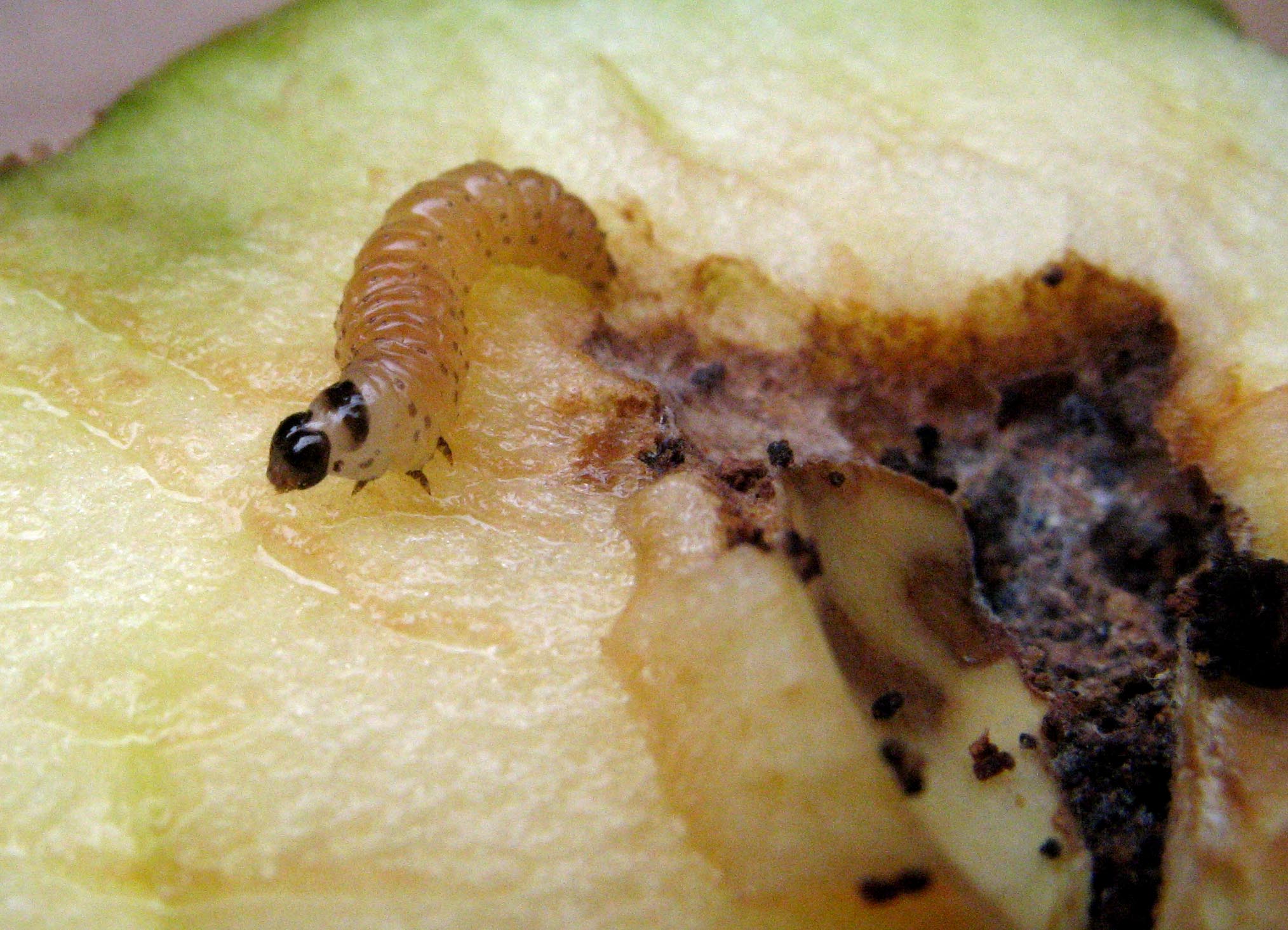A tribe of irreducible codling moths
In agriculture, biological alternatives to pesticides are being sought for environmental and health reasons. Use of a virus as a biocontrol agent for crop pests has become relatively widespread. One such example is Cydia pomonella granulovirus. It has been used for decades to target a crop pest that is fond of apples and pears: the codling moth. Miguel Lopez-Ferber, a researcher at IMT Mines Alès, has been working on this topic since 2005, the year in which the larvae of this insect developed resistance to a commercial product made from this granulovirus.
Cydia pomonella. Common name: codling moth. Adult moths measure approximately 18 millimeters long and are a brownish-gray color. Shortly after they hatch, larvae bore into orchard fruits and feed on them from the inside. The apples and pears are damaged and rot, so they are no longer suitable to be sold. However, these insects are very susceptible to a virus: their granulovirus, which is known as CpGV. If they come into contact with it, the larvae become ill and die, leaving the orchards healthy and untouched.
Unfortunately for apple trees, codling moths have developed resistance to CpGV, which poses a number of problems. For one, farmers need to find a new way to protect their orchards. And manufacturers need to determine whether it is possible to improve the viral preparation, find a substitute, or if production must be stopped. Then there’s the scientific question: “Codling moths have been in contact with this virus for millions of years and have never developed resistance to it. Why now?” wonders Miguel Lopez-Ferber, a researcher at IMT Mines Alès: “If there had been widespread resistance in the past, we would no longer find this virus in nature.”
One possible explanation is that, “we’ve underestimated the inventiveness of nature,” says Miguel Lopez-Ferber. “We’ve acted as if it were a chemical product: for years, exactly the same viral solution has been spread over orchards.” In nature, when an insect repeatedly comes into contact with the same chemical product, it will adapt and find a way to resist it. So the product will no longer work as well. Viruses, on the other hand, will also adapt and find new ways to reach the insects if we don’t prevent them from doing so – they are in co-evolution.
“It works the same way with humans, with the flu virus, for example,” explains the researcher. “We develop defenses to protect ourselves from the virus, but it evolves and comes back stronger the next year.” And CpGV exists in different forms throughout the world. There are slight variations in genotype – which is the sum total of an individual’s genes. And the solution available on the market corresponds to the culmination of research on a single isolated genotype of this virus.
Research to overcome resistance
With CpGV, the same virus isolate has been applied massively for years. This means that it’s possible that codling moth larvae are not resistant to other isolates of the virus. The different genotypes of the virus have been divided into 5 groups, from A to E. The “A” group is most similar to the Mexican isolate, which has been used historically. The researchers found that the other groups infected resistant larvae. At the beginning, however, the other viral isolates were less effective than those originally used – a greater quantity of product was needed for the same plot of land. But with a little selection, the performance reached the same levels as that of the original product. “We were also worried that we would observe resistance to these new genotypes in the future,” says Miguel Lopez-Ferber. But it is likely that this resistance phenomenon will not appear if there is greater viral diversity.
The researchers therefore tried another method: they combined the Mexican isolate to which the larvae had become resistant, with another genotype of the virus that infected the larvae. And they discovered that together, the two were even more effective in infecting the larvae. In a way, the second genotype, “opened the door to the one that had been blocked until then,” explains Miguel Lopez-Ferber, “but we still don’t really understand how it works.” The researchers are therefore studying how the different forms of the virus interact with one another to infect larvae. They could then use this knowledge to develop one or several optimal mixtures, by appropriately combining the specific characteristics of each genotype.
“Viral diversity is an asset, but we don’t yet fully understand how it works,” explains the researcher. “Imagine, for example, if we wanted to colonize a desert island. If all the colonists were miners, there’d be a lack of skills for building houses, planting crops etc. We need different, complementary jobs. That’s what we get when we combine several genotypes of a virus – except we don’t really know what their jobs are. We just know they work better together.”
And studying the virus’s behavior in codling moth larvae is no simple task. Let’s say that a type A and type B virus are dispersed in an orchard. How can we determine if a larva has absorbed both forms of the virus or only a single form? Or, if one of them has prevented the other from developing? In order to understand how the tasks are distributed, the researchers would must able to track A and B as they colonize the larva. The molecular tools available today are not the best suited for this. Miguel Lopez-Ferber’s team is currently working in partnership with NeoVirTech, a Toulouse-based company, to develop a better technique for tracking viruses.
[box type=”info” align=”” class=”” width=””]
The origins of granulovirus
“Using a natural predator to protect our harvests is not a new idea,” says Miguel Lopez-Ferber. “We domesticated cats to combat mice. It’s the same principle with granulovirus.”
It was in Mexico in 1964 that the codling moth granulovirus (CpGV) was discovered. Codling moth larvae were found dead and researchers sought to determine the cause. They then isolated the virus responsible: the Mexican isolate of CpGV. Shortly after, other forms of the virus were observed in Russia, followed by the United Kingdom. Slight variations existed between the viruses, subtle differences in genotype – the sum total of an individual’s genes. The Mexican isolate was favored for a potential commercial product because it was more homogenous. This made it easier to characterize in order to comply with regulatory criteria for insecticides, which are equivalent for phytosanitary and biological products and require rigorous identification of a product’s makeup.
After 25 years of research, the viral solution was ready for use and authorized for sale. In practice, it is used like a chemical product. A concentrated liquid solution is prepared in a tank and is then dispersed in a spray of fine droplets, ideally covering the entire orchard in a uniform manner. Starting in the 1990s, the product was widely used and applied several times a year. Until 2005, that is, when it was observed that codling moths were still present after the treatment.[/box]





Leave a Reply
Want to join the discussion?Feel free to contribute!